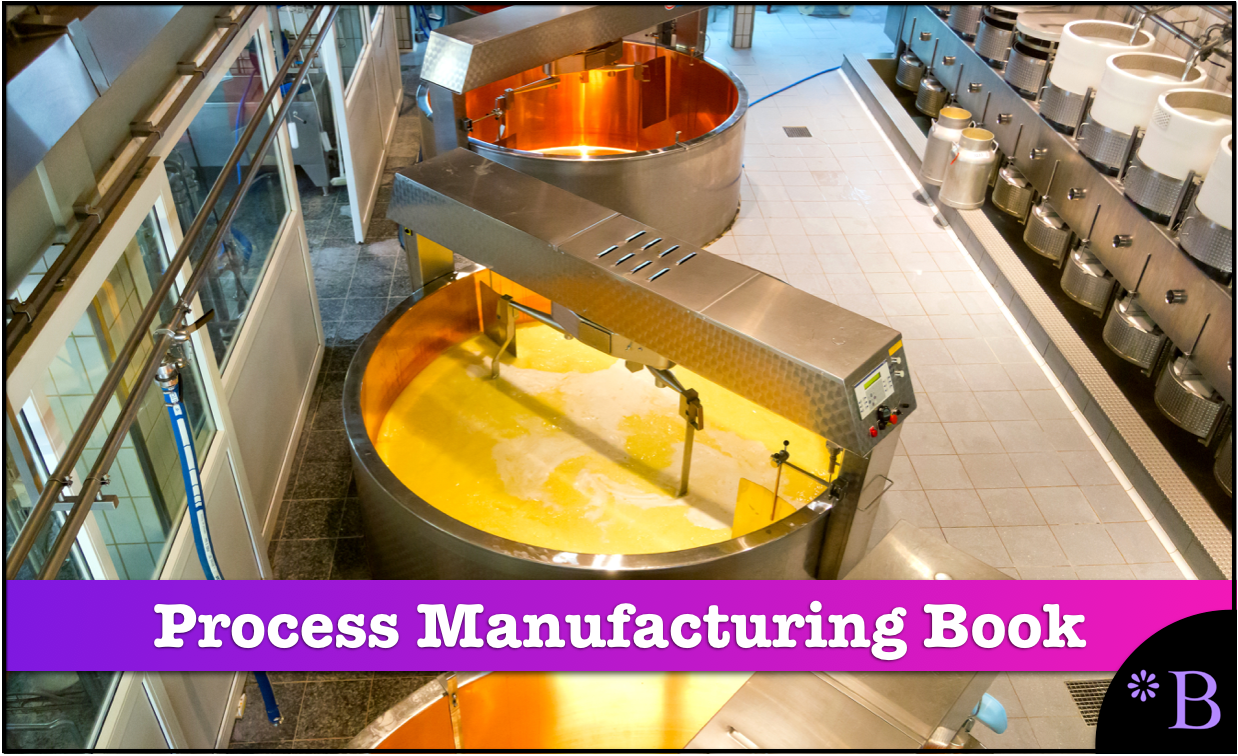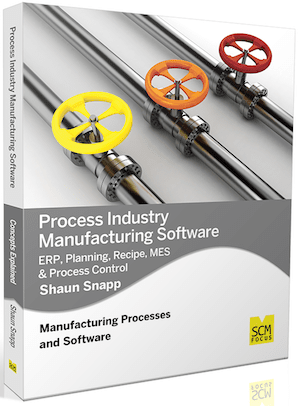
Process Industry Manufacturing Software: ERP, Planning, Process Control, Recipe Mgmt. & MES Software
Screenshots and examples from PlanetTogether, AspenTech, HamiltonGrant, ProcessPro, SAP APO, and SAP ERP.
What This Book Is About
The only book which covers process industry manufacturing software, this book covers many different types of process industry manufacturing environments. It describes how the planning needs of the process industries are so unique and stand apart from discrete or repetitive manufacturing. In the book, you will learn how to batch production and batch manufacturing is related to discrete production, and how batch production and batch manufacturing is also related to process manufacturing. And that batch production and batch manufacturing is a particular approach frequently used in the process industry.
The book also covers how to leverage specific functionality in multiple applications to meet typical process industry requirements.
The secret is out: you don’t have to make a planning application that is designed for discrete manufacturing fit your process industry needs. You have options.
From a distance, all process industry plants look the same. But under closer inspection, it’s clear that every plant is very different. Process industries have the widest variety of unique manufacturing requirements of all the manufacturing categories. For this reason, no off-the-shelf planning application will meet all the requirements. Through extensive graphics, screenshots—and links to videos available online—this book gives a thorough analysis of planning and the software solutions that meet the process industry’s unique and varied requirements.
Buy Now
By reading this book, you will:
- Understand the difference between process and discrete manufacturing and why software solutions designed for discrete manufacturing leave process industries with gaps in functionality.
- Examine batch and continuous processing within process industries.
- Lessen the confusion around terminologies, such as recipes, formulas, bill of materials, and more.
- Learn about standard software functionality designed for process industries.
- Know what to look for when selecting software to meet your business requirements for production planning.
- Explore the software applications from PlanetTogether, Arena Solutions, Hamilton Grant, and AspenTech and how their solutions meet the complexities of process industries.
Chapters
- Introduction
- The Discrete Manufacturing Focus of Production Planning and Scheduling Software
- Continuous Versus Batch Scheduling and Batch Production and Batch Manufacturing
- Recipes and Formulas Versus the Bill of Materials
- Overlapping and Leading and Lagging Operations
- Mixing/Blending/Pooling Operations
- Changeovers and Cleaning
- Process Industry Planning and Integrating with SAP ERP
- Conclusion
Table of Contents
Chapter 1: Introduction
- What Is Process Industry Manufacturing?
- Books and other Publications on the Process Industry
- The Book’s Production Orientation
- The Book’s Grounding in Reality
- Use of Graphics and Video in the Book
- Use of Vendors and Specific Applications in the Book
- Areas the Book Does not Cover
- Production Planning Methods
- Custom Solutions
- Simulation
- How Writing Bias Is Controlled at Brightwork Research & Analysis and Brightwork Research & Analysis Press
- The Approach to the Book
- The Brightwork Research & Analysis Site
- Use of Quotations
- Intended Audience
- Abbreviations
CHAPTER 2: The Discrete Manufacturing Focus of Production Planning and Scheduling Software
- Common Process Industry Planning Functionality
- Understanding the Differences Between Production Planning and Scheduling Applications
- Poor Software Selection as a Contributing
- Factor to the High Failure Rate of Enterprise Software Implementations
- Custom Coded Solutions
- Background on Custom Solvers
- The Production Planning and Scheduling Sweet Spot
- Conclusion
CHAPTER 3: Continuous Versus Batch Scheduling
- Continuous Production
- Gold Refining
- The Blast Furnace
- Oil Refining
- Textiles
- Paper
- Power Generation
- Moving From Batch to Continuous Manufacturing
- Batch Production and Batch Manufacturing
- Baked Items
- Paint
- Glass
- PlanetTogether and Batches
- Conclusion
CHAPTER 4: Recipes and Formulas Versus the Bill of Materials
- What is a BOM?
- MRP Explained
- Understanding Explosion
- Why Use a BOM as an Example?
- Recipes and Formulas
- Selecting the Recipe with Production Versions in SAP
- Creating and Reading Production Versions
- Recipes in SAP ERP
- Is Separate Nomenclature for Process Industry Constraint Master Data such as Recipes Necessary?
- Opening One’s Eyes
- Recipe Management with Hamilton Grant
- Industry-Specific Versus General BOM Management Applications
- Arena Solutions for the Process Industry
- Conclusion
CHAPTER 5: Overlapping and Leading and Lagging Operations
- The Importance of Timing in Process Industries
- The Importance of Temperature in Process Industries
- Leading and Lagging Operations in Software
- Conclusion
CHAPTER 6: Mixing/Blending/Pooling Operations
- Process Industry Manufacturing Complexity
- Conclusion
CHAPTER 7: Changeovers and Cleaning
- The High Emphasis on Changeovers
- Changeover Product Relationships
- Changeover Optimization in PlanetTogether
- Changeover Planning with the Setup Table
- Changeover Planning using Product Attributes
- Changeover Planning with Attribute Number Ranges
- Assignment of the Setup Tables to Resources
- Adding Resource Specificity to Changeover Planning
- Conclusion
CHAPTER 8: Process Industry Constraint Planning
- Planning Resource Variability
- A Resource’s Capabilities
- Individual-Resource Adjustment
- Min Max Limits on Resources
- Resource Variability in SAP APO
- Resource Variability in PlanetTogether
- AspenTech and Petroleum Planning
- Capacity Intervals in PlanetTogether
- Product Specific Resource Assignment
- Physical Properties Limitations
- Product Rules in PlanetTogether
- Compatible Scheduling Groups
- Movements Between Operations
- Connected Resources/Resource Connectors
- Material Handling Equipment Constraints
- Shared Input Constraints
- Conclusion
CHAPTER 8: Process Industry Planning and Integrating with SAP ERP
- Integrating to ERP for Master Data
- Integrating to SAP ERP for Transactions
- The Interaction Between External Planning System and SAP ERP
- The Split System Planning Approach
- The TextBook Approach to What Materials to Include in The Planning System
- Benefits of the Standard Approach
- Negative Aspects of The Standard Approach
- The False Assumption
- Where Did the Standard Approach Originate?
- Min Max Limits on Resources
Chapter 9: Conclusion

Buy Now
Questions about the Book?
Do you have any questions about the book? If so, please leave us a comment in the message box to the right, and we will address them.